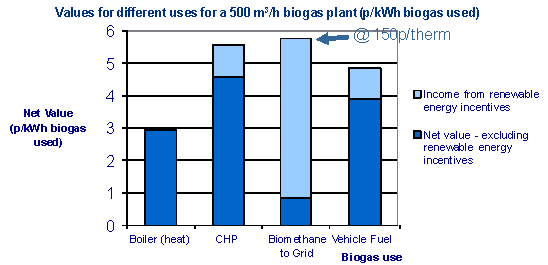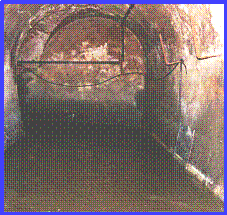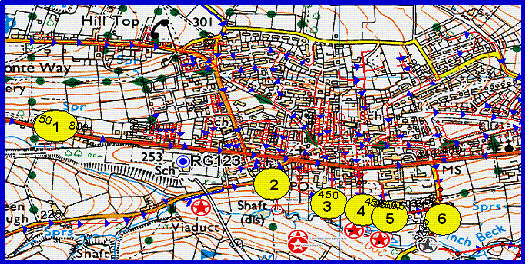Wastewater Forum Archive
WASTEWATER RESEARCH AND INDUSTRY SUPPORT FORUM
Meeting 25th November 2009
Please note that for older reports some links will be to sites that are no longer active.
This was the Forum’s 39th meeting. It was held in the Boardroom of the Chartered Institution of Water & Environmental Management (CIWEM) in London. Members of CIWEM’s Wastewater Management Panel joined the Forum for the technical presentations and discussion which were on research into increasing the efficiency of UV disinfection of treated wastewater, maximising the value of biogas and biological processes in sewers.
Increasing the efficiency of UV treatment
 Clare Warren of Optima Design Services Ltd and Bob Goodman of Xcel Systems described a research proposal that has been short-listed by the Carbon Trust to increase the efficiency of treating the water recovered at wastewater treatment works (WwTW) with ultraviolet (UV) light. UV treatment is widely used in the UK to ensure that bathing water quality is not jeopardised but it has a large energy (and hence carbon) cost. The aim of the research is to increase the effectiveness of UV delivery by means of improving the geometry and feedback from sensors such that within 5 years 1 million tonnes CO2e will be saved and 40% saving in cost. Some of the people attending had experience of designing, operating and regulating UV treatment so the discussions were detailed, well informed and very useful to Optima and Xcel. The Forum agreed that this project holds great potential and hoped that the Carbon Trust will fund it. FWR and CIWEM have both sent letters of support.
Clare Warren of Optima Design Services Ltd and Bob Goodman of Xcel Systems described a research proposal that has been short-listed by the Carbon Trust to increase the efficiency of treating the water recovered at wastewater treatment works (WwTW) with ultraviolet (UV) light. UV treatment is widely used in the UK to ensure that bathing water quality is not jeopardised but it has a large energy (and hence carbon) cost. The aim of the research is to increase the effectiveness of UV delivery by means of improving the geometry and feedback from sensors such that within 5 years 1 million tonnes CO2e will be saved and 40% saving in cost. Some of the people attending had experience of designing, operating and regulating UV treatment so the discussions were detailed, well informed and very useful to Optima and Xcel. The Forum agreed that this project holds great potential and hoped that the Carbon Trust will fund it. FWR and CIWEM have both sent letters of support.
Maximising the Value of Biogas
James Newton of Mott MacDonald discussed the results of a UKWIR funded project that had been completed in April 2009. It had two principal objectives:
- “Provide a clear appraisal of the technologies and the costs involved in maximising the potential of biogas produced from the digestion of sewage sludge
- Identify the potential benefits arising from biogas optimisation and the ‘regulatory blockers’ that stand in the way of achieving full benefit”

For the base case, using biogas for CHP (Combined Heat and Power, where the waste heat from the engine used to run the generator is used for digester heating and building heating) for on-site use would achieve the highest value for a water company – with use as a vehicle fuel next most attractive. Even in efficient engines, only 40% of the biogas energy is produced as electricity. However, the financial balance is highly sensitive to:
- Values of the various renewable energy incentives (which in some cases government has still not established)
- Site specific factors such as: the cost of connecting to the grid, whether there is a use for heat off site, whether there is a vehicle operator who could use CNG (compressed natural gas)
- Treatment under the CRC (Carbon Reduction Commitment)
These and other factors require a site-specific analysis.

The report concluded there are no regulatory ‘blockers’ to prevent water companies’ appointed businesses using biogas in either CHP or as a fuel for Water Co vehicles – provided their customers benefit from the investments they fund. Water companies have a strong financial incentive to invest in biogas energy schemes - both capital and operating costs are funded for appointed businesses. However there is a very real blocker to co-digestion. Co-digestion could have major financial and environmental benefits, one very obvious example would be where the quantities of several waste streams was marginal or insufficient for mono-digestion but if combined, co-digestion would be viable.
Key renewable energy incentives are uncertain. The Renewable Heat Incentive and the Feed In Tariff are still to be established (levels and mechanisms) as are future values of Renewable Transport Fuel Obligation and Carbon Reduction Commitment credits – hence there is still significant uncertainty regarding values that alternative uses of biogas might have in the future. Entrepreneurialism and imagination are not being encouraged. The most valuable use of biogas is likely to be CHP generation as has been practiced for 70 years.
One surprising finding was that in some companies there is still opportunity from maximising biogas production and electricity generation by minimising downtime of critical plant. Cases were found where digester mixing had been broken and not repaired for several weeks and likewise biogas engines. Many sites are not monitoring biogas production effectively; even where it is, some sites do not use data and ratios to produce key performance indicators for management information.
The report concluded Water Companies should increase biogas production through optimisation of digester operation, including where cost effective, implementing advanced AD. Optimising biogas production may achieve greater benefits (financial and environmental) than changing the biogas use alone.
 In-sewer processes – microbiology and biofilms
In-sewer processes – microbiology and biofilms
Dr Catherine Biggs, EPSRC Advanced Research Fellow and Reader, Dept. Chem. & Process Eng. University of Sheffield and Dr Henriette Jensen, a member of her research team presented this work which is funded by an EU FP6 Marie Curie Transfer of Knowledge Grant. Too little is known about the biological transformations that happen in sewers, which is an important aspect of wastewater management; this project intends to reduce the knowledge gap. Less than 1% of bacteria are culturable from most environments using classical techniques and therefore DNA (PCR) is being used for population profiling and enumeration, this will detect even rare organisms. Reactors will be used to look at the kinetics of substrate transformation. The work will progress to monitoring in a well characterised sewer network, especially to examine the effect of sewage velocity on microbiology.
Field monitoring has demonstrated that the techniques work and have good reproducibility. There was great similarity between samples of biofilm taken at a particular site but samples differ between sites.  This suggests the ecology is determined by the sewage, factors could be the composition, flow, depth-fluctuation and temperature. In addition, biofilm taken from deep in the flow (permanently submerged) differs from biofilm in the “intertidal” zone. Biofilms are different from the bulk of the flow.
This suggests the ecology is determined by the sewage, factors could be the composition, flow, depth-fluctuation and temperature. In addition, biofilm taken from deep in the flow (permanently submerged) differs from biofilm in the “intertidal” zone. Biofilms are different from the bulk of the flow.

 Clare Warren of Optima Design Services Ltd and Bob Goodman of Xcel Systems described a research proposal that has been short-listed by the Carbon Trust to increase the efficiency of treating the water recovered at wastewater treatment works (WwTW) with ultraviolet (UV) light. UV treatment is widely used in the UK to ensure that bathing water quality is not jeopardised but it has a large energy (and hence carbon) cost. The aim of the research is to increase the effectiveness of UV delivery by means of improving the geometry and feedback from sensors such that within 5 years 1 million tonnes CO2e will be saved and 40% saving in cost. Some of the people attending had experience of designing, operating and regulating UV treatment so the discussions were detailed, well informed and very useful to Optima and Xcel. The Forum agreed that this project holds great potential and hoped that the Carbon Trust will fund it. FWR and CIWEM have both sent letters of support.
Clare Warren of Optima Design Services Ltd and Bob Goodman of Xcel Systems described a research proposal that has been short-listed by the Carbon Trust to increase the efficiency of treating the water recovered at wastewater treatment works (WwTW) with ultraviolet (UV) light. UV treatment is widely used in the UK to ensure that bathing water quality is not jeopardised but it has a large energy (and hence carbon) cost. The aim of the research is to increase the effectiveness of UV delivery by means of improving the geometry and feedback from sensors such that within 5 years 1 million tonnes CO2e will be saved and 40% saving in cost. Some of the people attending had experience of designing, operating and regulating UV treatment so the discussions were detailed, well informed and very useful to Optima and Xcel. The Forum agreed that this project holds great potential and hoped that the Carbon Trust will fund it. FWR and CIWEM have both sent letters of support.

 In-sewer processes – microbiology and biofilms
In-sewer processes – microbiology and biofilms This suggests the ecology is determined by the sewage, factors could be the composition, flow, depth-fluctuation and temperature. In addition, biofilm taken from deep in the flow (permanently submerged) differs from biofilm in the “intertidal” zone. Biofilms are different from the bulk of the flow.
This suggests the ecology is determined by the sewage, factors could be the composition, flow, depth-fluctuation and temperature. In addition, biofilm taken from deep in the flow (permanently submerged) differs from biofilm in the “intertidal” zone. Biofilms are different from the bulk of the flow.